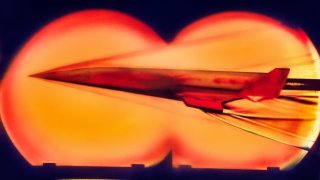The U.S. Military's Nightmare: Lasers Can't Beat Hypersonic Missiles (Yet)
Lasers theoretically offer a speed advantage due to their light-speed travel and unlimited "ammunition," they face significant technological challenges, such as power output, atmospheric interference, and precision targeting. Currently, these limitations make lasers an unreliable solution for defending against hypersonic missile threats.
The Question: Lasers, or Directed Energy Weapons (DEWs), have been proposed as a potential defense against hypersonic missiles, which travel at speeds of 5 to 25 times the speed of sound.
The Problem: Unlike traditional ballistic missiles, hypersonic missiles follow unpredictable trajectories, making them difficult to track and intercept.
Answer No One Wants to Hear: Lasers theoretically offer a speed advantage due to their light-speed travel and unlimited "ammunition," they face significant technological challenges, such as power output, atmospheric interference, and precision targeting. Currently, these limitations make lasers an unreliable solution for defending against hypersonic missile threats.
Lasers vs. Hypersonic Weapons: Who Wins?
Can lasers defend against hypersonic weapons?
Nation-states have always been willing to invest heavily in the development of more advanced and more lethal weapons technologies. The 20th century stood out in this regard. Nuclear weapons were developed, but so were tanks, airplanes, cruise missiles, and spy satellites. Perhaps no other century saw such an accelerated rate of new weapons development.
The efforts have continued into the 21st century, of course. One of the more notable developments of late is the hypersonic missile. Technically, the hypersonic weapon was designed and developed in the 1930s by Nazi Germany. But the weapon didn’t gain practical traction until recent years.
As the name implies, a hypersonic missile is a missile capable of traveling at hypersonic speeds - anywhere between 5 and 25 times the speed of sound. At such speeds, an object would need just one second to travel 1 to 5 miles. And as you might imagine, it is hard to defend against an object moving that fast.
Defending Against the Undefendable
Russia and China have invested heavily in hypersonic weapons, prompting U.S. officials to wonder whether they have the capability to defend against such fast-moving weapons. Nothing in America’s conventional defensive arsenal is equipped to reliably subdue a hypersonic missile attack. But could lasers (Direct Energy Weapons) perhaps be the answer? Probably not.
Part of the problem is the flight trajectory of the hypersonic missile.
A ballistic missile takes a predictable flight path, which allows air defense systems to identify and track inbound sensors with radar and computer calculations. The hypersonic missile is different.
“Rather than achieving hypersonic speeds by flying along a predictable ballistic flight path, hypersonic boost-glide weapons and hypersonic cruise missiles both change course unpredictably while flying at these extreme speeds,” Alex Hollings writes. “As a result, an air defense system’s calculations to predict the remainder of the weapon’s flight path are rendered more or less moot, and because of their high closing speed, there’s little to no time left to attempt a recalculation.”
Lasers were conceived as a potential solution. Lasers travel at the speed of light – faster than a hypersonic missile. They can be fired for as long as an energy source is available (whereas an air defense system, like the Patriot, has just a few interceptors). So in theory, the laser makes sense as a defense against hypersonic missiles.
But in application, lasers fall short.
“There are several serious technological limitations that prevent [lasers] from being used to take down incoming hypersonic, or even ballistic missiles,” Hollings wrote, like power output, line of sight, atmospheric scattering, thermal blooming, and beam control.
Laser technology is just not reliable enough to handle the challenge of thwarting a hypersonic missile.
About the Author: Harrison Kass
Harrison Kass is a defense and national security writer with over 1,000 total pieces on issues involving global affairs. An attorney, pilot, guitarist, and minor pro hockey player, Harrison joined the US Air Force as a Pilot Trainee but was medically discharged. Harrison holds a BA from Lake Forest College, a JD from the University of Oregon, and an MA from New York University. Harrison listens to Dokken.
Image Credit: Creative Commons.


